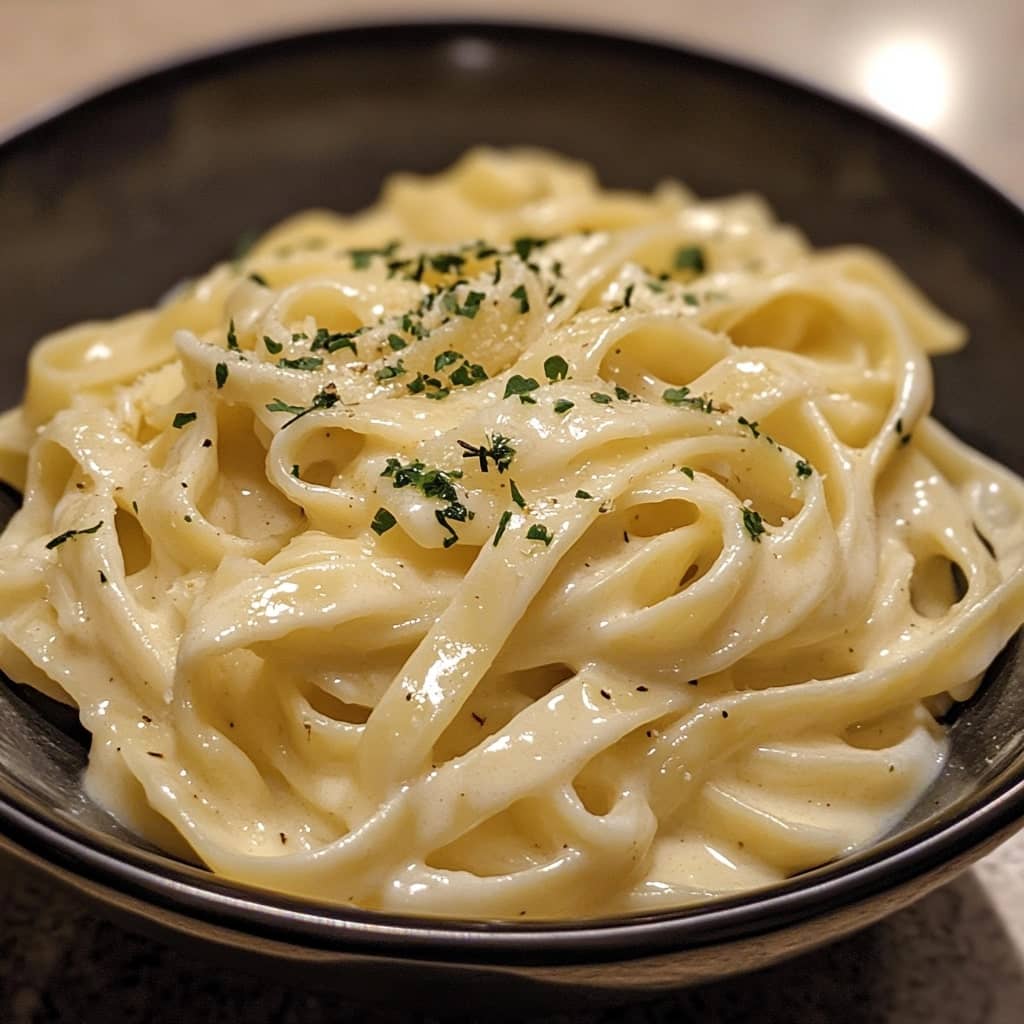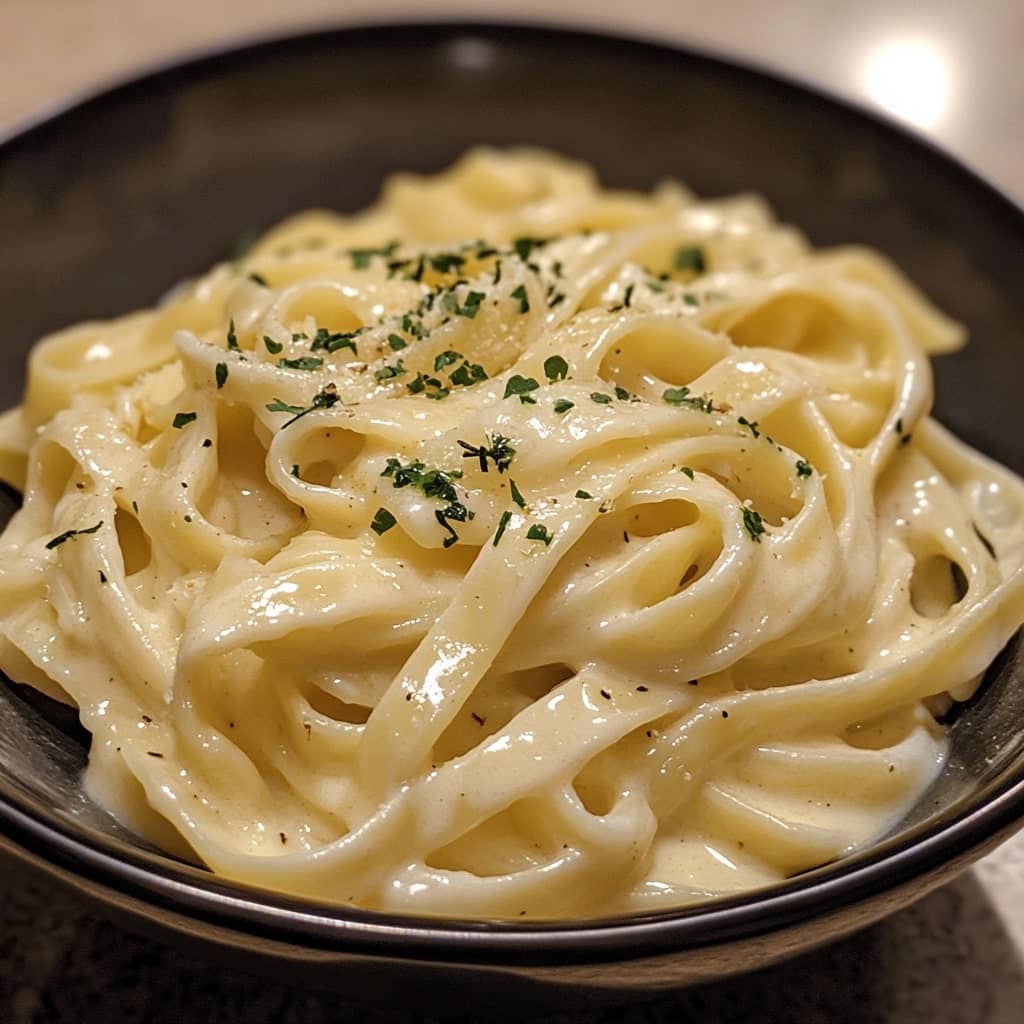Introduction
Fettuccine Alfredo is a classic Italian pasta dish that has become a beloved comfort food worldwide. Known for its rich and creamy sauce, Fettuccine Alfredo combines tender fettuccine pasta with a luxurious sauce made of butter, heavy cream, and Parmesan cheese. It has a decadent, velvety texture that has made it a go-to dish for many home cooks and restaurant menus. While often considered an American creation, its roots trace back to Italy, where a version of the dish was originally made with just butter and cheese. The simplicity and indulgence of Fettuccine Alfredo make it a perfect dish for any occasion, from a casual family meal to a festive gathering.
The History of Fettuccine Alfredo
The origins of Fettuccine Alfredo date back to the early 20th century in Rome, Italy. The dish was first created by Alfredo di Lelio, who owned a restaurant called “Alfredo’s” in the city. According to popular legend, Alfredo made the dish for his wife, who was experiencing pregnancy-related nausea and needed something comforting and easy to eat. He combined fettuccine pasta with a sauce made of butter and Parmesan cheese, creating a simple yet rich dish that quickly became a hit. The dish later made its way to America, where it was adapted with the addition of cream and became the creamy version we know today. Despite its American popularity, Fettuccine Alfredo remains a dish that is primarily served with butter and cheese in Italy, where it’s often enjoyed as a special treat.
Ingredients Breakdown
To make Fettuccine Alfredo, you will need the following ingredients:
- Fettuccine pasta: This broad, flat pasta is the traditional choice for Alfredo due to its ability to hold onto the creamy sauce.
- Butter: Unsalted butter is best, as it allows you to control the seasoning. The butter creates the base of the sauce and contributes to its smooth texture.
- Heavy cream: This adds the rich, creamy consistency to the sauce. It’s what gives Alfredo its signature velvety mouthfeel.
- Parmesan cheese: Freshly grated Parmesan is essential for the best flavor. It adds a nutty, salty taste that balances the richness of the butter and cream.
- Salt and pepper: These basic seasonings help to enhance the flavors of the dish. Freshly cracked black pepper is especially important for a touch of heat.
- Garlic (optional): Some variations of Fettuccine Alfredo include a hint of garlic for extra flavor.
- Parsley (optional): A sprinkle of fresh parsley can be used for garnish, adding a pop of color and a hint of freshness.
Step-by-Step Recipe
- Begin by cooking the fettuccine pasta in a large pot of salted boiling water. Follow the package instructions for al dente pasta, which usually takes around 8-10 minutes. Once the pasta is cooked, drain it, reserving about 1/2 cup of pasta water.
- In a large skillet or saucepan, melt the butter over medium heat. Once the butter has melted, add the heavy cream and stir to combine. Allow the mixture to simmer gently for 3-5 minutes, stirring occasionally, until it thickens slightly.
- Add the grated Parmesan cheese to the butter and cream mixture, stirring continuously until the cheese is fully melted and the sauce becomes smooth and creamy.
- Season the sauce with salt and pepper to taste. If you’re using garlic, add it at this point and cook for another 1-2 minutes.
- Add the cooked fettuccine pasta to the sauce, tossing gently to coat the pasta evenly. If the sauce is too thick, add a little reserved pasta water, a tablespoon at a time, until the desired consistency is achieved.
- Once the pasta is coated with the sauce, remove the pan from the heat. Serve immediately, garnished with freshly grated Parmesan cheese and chopped parsley, if desired.
Tips for the Perfect Fettuccine Alfredo
- Use freshly grated Parmesan cheese for the best flavor and texture. Pre-grated cheese often contains anti-caking agents that can prevent it from melting smoothly.
- Be sure to reserve some pasta water before draining the fettuccine. This starchy water helps thicken the sauce and ensures the pasta and sauce bind together well.
- Don’t overcook the pasta, as it will continue to cook slightly when combined with the hot sauce.
- For a silkier sauce, use a combination of butter and cream in the right proportions. Too much butter can make the sauce greasy, while too much cream can make it too rich.
- Keep the heat low when simmering the cream and butter mixture to prevent the sauce from breaking or curdling. Stir continuously to ensure the cheese melts evenly.
Variations and Customizations
While the classic Fettuccine Alfredo is delicious on its own, there are numerous variations and customizations you can make to suit your preferences. For a lighter version, try using half-and-half or a combination of milk and cream. You can also add cooked chicken, shrimp, or vegetables like broccoli or spinach to make the dish more filling and nutritious. For a flavor twist, consider incorporating lemon zest, roasted garlic, or a pinch of nutmeg. For those who prefer a spicier dish, a dash of red pepper flakes can add an exciting kick. If you’re looking for a dairy-free or vegan version, you can substitute the cream and butter with plant-based alternatives like coconut milk and vegan butter, and use nutritional yeast instead of Parmesan cheese.
Health Considerations and Nutritional Value
Fettuccine Alfredo is known for being indulgent and calorie-dense, but it can still be enjoyed as part of a balanced diet when consumed in moderation. A typical serving of Fettuccine Alfredo contains around 500-700 calories, depending on the ingredients used and portion size. The dish is rich in fats and carbohydrates, which provide energy but can be high in saturated fats, especially from the butter and cream. To make it healthier, consider reducing the amount of butter and cream, or using lower-fat alternatives. You can also increase the nutritional value by adding vegetables like spinach, peas, or mushrooms, which add fiber, vitamins, and minerals. For a protein boost, consider adding grilled chicken or seafood to the dish.
FAQ
- Can I make Fettuccine Alfredo ahead of time?
Yes, Fettuccine Alfredo can be made ahead of time and stored in the refrigerator for up to 2 days. Reheat it gently on the stovetop with a splash of milk or cream to restore its creamy consistency. - Can I use a different type of pasta?
While fettuccine is traditional, you can use other types of pasta, such as penne, linguine, or even spaghetti, if desired. - How can I make a healthier version of Fettuccine Alfredo?
To make a healthier version, use less butter, opt for a lighter cream or milk, and add more vegetables for added fiber and nutrients. - Can I freeze Fettuccine Alfredo?
Fettuccine Alfredo can be frozen, but the texture of the sauce may change upon reheating. To freeze, allow the dish to cool completely, then store in an airtight container. To reheat, gently warm it on the stove, adding a little cream or milk to smooth out the sauce. - Can I make a vegan version of Fettuccine Alfredo?
Yes! You can make a vegan version by using plant-based butter, cream (such as coconut milk), and nutritional yeast in place of Parmesan cheese.

Fettuccine Alfredo
Ingredients
Method
- Bring a large pot of water to a boil over high heat. Add salt to season the water. Once it reaches a boil, add the fettuccine and cook according to the package directions.
- In a large skillet or pan, melt the butter over medium heat. Add the minced garlic and cook for 1 to 2 minutes. Then, stir in the heavy cream. Let the cream simmer and reduce for 5 to 8 minutes. Add half of the Parmesan cheese and whisk until the sauce is smooth. Keep it on the heat, whisking until the cheese is fully melted.
- Reserve some of the pasta water, as it’s packed with flavor and can help thin the sauce if needed. Toss the cooked fettuccine with the Alfredo sauce and add the remaining Parmesan cheese. If necessary, add a bit of pasta water to reach the desired consistency.
- Finish by garnishing with Italian parsley, if desired.
Notes
If you prefer a saucier dish, you can use less than 1 lb. of fettuccine pasta.
Leftover pasta water can be used to thin the pasta sauce if needed.
